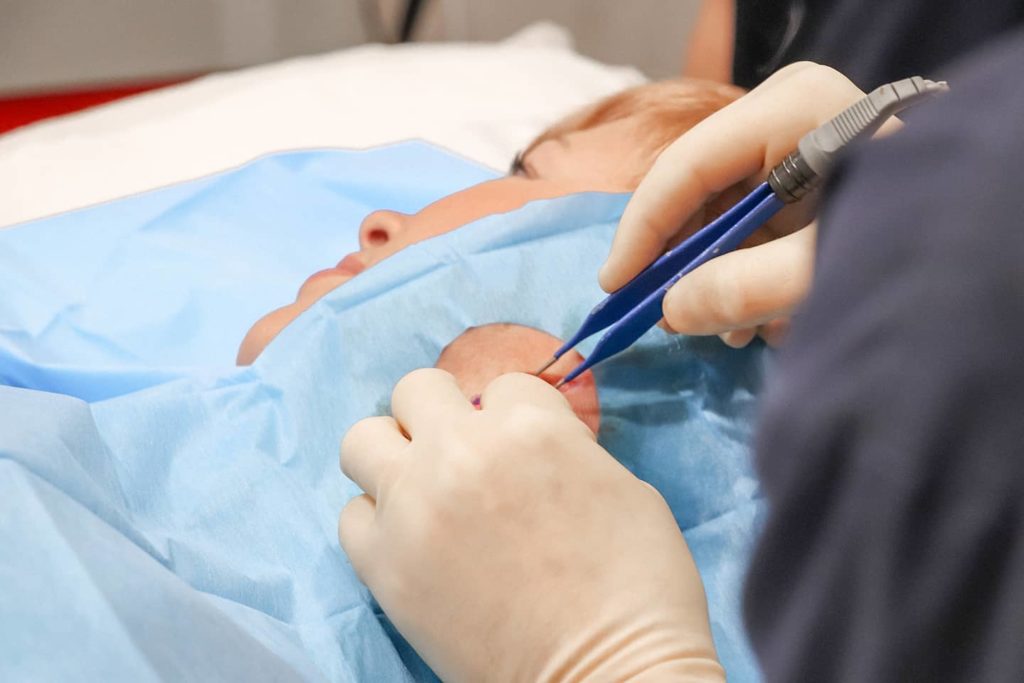Melanoma Treatment Auckland New Zealand
Dr. Mark Gittos offers melanoma surgery, treatment and evaluation in Auckland, New Zealand . Dr Gittos is a plastic and reconstructive surgeon and is well known for treating skin cancers.
About Melanoma
New Zealand & Australia have the biggest melanoma incidence rate on the globe. The risk of getting diagnosed with the ailment by the time a patient reaches the age of 85 is 1 in 21 for women. Compared to 1 in 13 for men. (1)
But, the elderly are not the only ones at risk of this condition. Melanoma is particularly a widespread form of cancer in 20- to 39-year-olds. Luckily, research is making a difference. In the last couple of years, plenty of treatments have been tailored to extend the life expectancy in patients with the disease. (2)
Targeted treatments can make a big difference. Especially when the ailment is caught early. Here is a detailed guideline of the typical melanoma characteristics and the viable treatment opportunities.

Malignant Melanoma Characteristics
Melanoma is a type of skin carcinoma that forms when the melanocytes begin growing out of hand. These melanocytes are in fact the cells responsible for providing the skin with a brown or tan colour. (3)
Even if this carcinoma is less prevalent than some other types of cancer of the skin, it is very dangerous and has bigger odds of spreading. Especially when left untreated for an extended period of time. In many of those people affected, melanoma won’t cause symptoms.
But, a change in the way an existing mole looks or feels can be a clear indicator of melanoma. Typical melanoma characteristics include a change in features of a current mole. Or a new one that includes some of the following warning signs of malignant melanoma:
- Irregular border
- Asymmetry
- Raised surface
- Larger diameter than 6mm
- Change in colour (red, blue, white tones on a black/brown lesion). (4)
The affected mole can take on a different colour, shade, or appear blotchy. Melanoma can increase the mole’s size and cause it to take an irregular shape. For, example, a mole with a bigger height and asymmetrical shape.
The surrounding tissue can also appear elevated. Due to the ailment, the mole can become vulnerable, itch, and bleed. Other malignant melanoma symptoms include darker spots on the membrane lining of the anus, vagina, or mouth. Including dark spots beneath the nails. (5)
Where Does Melanoma Usually Start?
It can emerge on any area of the skin. But, people most often develop it on their body trunk, like their backs or chest in males, and on the legs in female patients. The face and neck may also be affected. But, the melanoma location will vary from person to person.
So, how serious is malignant melanoma?
This is an invasive ailment with a high risk of death. It is a very serious ailment. However, if caught in its early stages, it has a high cure rate. According to the National Institutes of Health, this is the deadliest form of cancer.
But, in its early stages, treatment with surgery alone can be successful and offers solid recovery. However, if the melanoma spreads (metastasized), the survival rate can drastically plummet. That’s why proper and early diagnosis remains a key priority. And surgery can turn the tide. (6)
What Kind of Surgery Is Done for Melanoma?

Melanoma Surgery is the best treatment modality for curing invasive and localized melanoma. It offers a general 92% five-year survival rate. Different surgical options can help remove a melanoma. These options include: (7) (8)
- Wide local excision (WLE) – This melanoma wide excision is meant to take out a tiny area of tissue that’s been affected. After removing the tissue, the wound is closed and sutured. Most of the time, a 1 to 2 cm margin is removed around the affected site of the melanoma. But, the size of the wound and duration of the wide excision surgery will vary depending on how deep the tumour is or how far it has spread. Bigger excisions might need skin flaps or skin grafts. Reconstructive and plastic surgery for melanoma can replace the area that’s been removed. (9)
- Mohs surgery – This surgery is helpful when the melanoma affects the ears, scalp, face, or other highly visible areas of the body. The goal is to spare the normal skin if possible. Mohs surgery, however, can only treat the early stages of melanoma. Also known as lentigo maligna melanoma. (10) – PLease note that Dr Gittos does not perform Moh’s Surgery
- Staged excision – This surgery can remove shallow melanoma. But, the patient might have to do two or more treatments to get the desired result. If there is still melanoma present, then the area can be reassessed.
Can Malignant Melanoma Be Removed?
People want to know can melanoma be surgically removed? And the answer is yes. Surgical excision can be used to cut the early melanoma out and remove any of the melanoma cancerous cells. The melanoma removal process usually is carried out in two procedures. The diagnostic excision and the removal itself.
The extent of the surgery will vary based on the thickness of the melanoma. The majority of cases are located when they are less than 1 mm thick. In examples such as these, outpatient surgery can remove the ailment. In stage 0 melanoma, the doctor could remove a margin of the skin, which is a minimum of 5mm around the carcinoma. But the width becomes bigger in more serious cases. (11)
How Quickly Should Melanoma Be Removed?
Most melanoma or 84% is caught early as a localized ailment, which has a relatively high 5-year survival rate of 98%. Despite the current advances in cancer treatment, for a distant disease, the 5-year survival rate drops to only 15%.
That’s why it’s critical to have melanoma removal surgery as soon as possible. Experts suggest getting treatment in the first 4 to 6 weeks. Although the surgical intervals will vary between clinics, almost all are within a 6-week time period. (12)
So, what happens when you have melanoma removed? The tissue that’s been taken out is then evaluated to see if it has any melanoma cells along its edges. These edges are what experts call “margins”. If the margins are cancer-free, then the skin can get back in shape.

Are You Awake for Melanoma Surgery?
Do they put you to sleep to remove melanoma? This is a question that often pops up for those in need of melanoma surgery. Overall, malignant melanoma surgery is a small procedure and when done in an outpatient setting, there is no need to be put to sleep. Patients receive a local anaesthetic. In other words, you are awake.
The anaesthesia makes the area numb so that a trained surgeon can remove thin layers of the skin. After the affected tissue has been taken out, the doctor will close up the area with stitches. These stitches can feel somewhat tight.
However, as the skin naturally heals, that tightness subsides. Patients are put to sleep if the surgeon has to take out a bigger portion of their skin or do a sentinel node biopsy. This biopsy is meant to evaluate their lymph nodes. If the melanoma has reached these nodes, then a lymph node dissection is necessary. This is a surgical procedure meant to take out the lymph nodes. (13)
Post Melanoma Surgery Recovery Time
So, how long does it take to heal after melanoma surgery? The answer is – it depends. Most wounds need 1 to 3 weeks to recover. But, if you had a skin graft, which means a bigger portion of the skin was taken out, then the natural rejuvenation process can take longer.
Dr Gittos will suggest pain meds or prescription pain killers for those struggling with the discomfort and wide excision melanoma pain. But, it’s completely normal for the wound to feel sore after malignant melanoma surgery.
Based on where the wound is, your doctor can suggest some practical ways how to get back to your daily activities and resume a normal way of life. But, don’t forget to take your time. Everyone can recover at their own pace.
Give your body everything it needs to facilitate the recovery process. That means taking good care of your skin, consuming nutritious foods, and following your doctor’s guidelines. Especially on adequate wound care after melanoma removal. With enough care, you can quickly get the results you are looking for. (14)
FAQs about Melanoma

What does Stage 1 melanoma mean?
- It means you are dealing with localized disease, only in the skin and very thin. The body has cancer cells in both the dermis and epidermis. Stage 1 melanoma has yet to spread to far-away sites or the lymph nodes. The melanoma is not over 1 mm thick, which is roughly as big as a sharpened pencil point. It could be with or without broken skin (ulceration).
Why are melanoma scars so big?
- The scars from melanoma are almost twice as big as those from other skin carcinomas. That’s because melanoma has bigger odds of spreading. And when it affects a larger portion of the healthy tissue, that’s when the wounds during surgery get bigger, and scars remain.
How long does excision surgery take?
- A wide local excision typically takes 1 hour. Patients tend to spend another hour in the recovery ward to curb the sickness and discomfort they might be feeling after the procedure. With staged excision, the duration is different. (15) Since you may need multiple visits, the results can take anywhere from 2 days to 2 weeks. If the skin is still affected, then the doctor will re-excise the wound on your next visit. But, when it comes to Mohs surgery, it is difficult to predict how long it will take. It’s a good idea to plan as though the procedure will take all day. Even if the chances are low for it to last that long.
What is the most common margin for melanoma removal?
- According to the National Institutes of Health, for thin melanoma it is a 1-cm margin (or less than a millimetre thick), for 1- to 2-mm melanomas, it is a 1- to 2-cm margin, and for melanoma, with intermediate thickness, it’s a 2-cm margin. (16)
What is the most aggressive form of melanoma?
- Nodular melanoma is by far the most aggressive form of cutaneous melanoma. It represents 14% to 30% of melanoma cases. It takes the form of a dark, often black bump. However, lesions could take other colours or feature a colourless skin tone. (17)
Does melanoma show up in blood work?
- Blood tests are not meant to screen for skin cancer or diagnose melanoma. A biopsy is the only way for a doctor to figure out if the patient has melanoma. They will take a small tissue sample and test it in a laboratory.
How often does melanoma come back?
- In many patients, the melanoma returns in the first 5 years post malignant melanoma treatment. But, if you are melanoma-free for 10-years, the odds of the ailment coming back are relatively lower. Yet, it can still happen. Get a regular check-up to see how well your skin is doing post melanoma treatment.
How can you tell if melanoma has spread?
- Talk to a doctor. In more advanced cases, experts might suggest you do imaging tests to spot the signs of melanoma spreading. These tests can include PET scans, CT scans, or X-rays. The doctor will also evaluate the skin for any hardened lumps, swelling, pain, and so on.
What does Stage 2 melanoma look like?
- This is a localized ailment that’s thicker than Stage 1. The tumour has penetrated the skin deeper than 1 mm. Sometimes, the affected area has ulcerated, but it doesn’t always have to be the case. Even if the tumour might not be advanced, it is susceptible to spreading.
Can melanoma spread after removed?
- Despite being removed, melanoma can come back. When that happens, it could spread. It’s critical to keep regular appointments with your surgeon to make sure your skin is in a healthy shape.
How much does it cost to have a melanoma removed?
- The wide excision melanoma surgery cost or the cost of any treatment will vary based on the stage of the disease and phase of care. The costs are the highest in patients with late-stage disease.
Medical References for Melanoma
- https://www.cancer.org.au/cancer-information/types-of-cancer/melanoma
- https://www.melanoma.org.au/understanding-melanoma/melanoma-facts-and-statistics/
- https://www.cancer.org/cancer/melanoma-skin-cancer/about/what-is-melanoma.html
- https://www.ncbi.nlm.nih.gov/books/NBK470409/
- https://www.cancer.org.au/cancer-information/types-of-cancer/melanoma
- https://www.ncbi.nlm.nih.gov/pmc/articles/PMC6804807/
- https://www.ncbi.nlm.nih.gov/books/NBK481850/
- https://pubmed.ncbi.nlm.nih.gov/31264932/
- https://www.melanoma.org.au/understanding-melanoma/treatment-options/surgery/wide-local-excision/
- https://www.aad.org/public/diseases/skin-cancer/types/common/melanoma/mohs-surgery
- https://www.cancer.net/cancer-types/melanoma/types-treatment
- https://www.ncbi.nlm.nih.gov/pmc/articles/PMC4212669/
- https://www.cancerresearchuk.org/about-cancer/melanoma/treatment/surgery/surgery-remove-melanoma
- https://myhealth.alberta.ca/Health/aftercareinformation/pages/conditions.aspx?hwid=abp7912
- https://www.ouh.nhs.uk/patient-guide/leaflets/files/68978Psentinel.pdf
- https://www.ncbi.nlm.nih.gov/pmc/articles/PMC3104911/
- https://www.ncbi.nlm.nih.gov/pmc/articles/PMC4764970/
- https://www.ncbi.nlm.nih.gov/pmc/articles/PMC4495902/
About Dr Mark Gittos FRACS (Plast) – New Zealand Plastic Surgeon
Practice locations in Herne Bay Auckland, Northland and Bay of Plenty – Kerikeri, Whangarei, New Plymouth & Tauranga
Dr Mark Gittos is a leading Specialist Plastic Surgeon and operates a practice in Herne Bay, Auckland and in the UK. The practice focuses on both surgical and non-surgical procedures, each designed to help restore, improve or change a physical characteristic or problem. The first step in every case is to talk through your personal requirements and explore all the options, before deciding on the most effective solution.
Dr Mark Gittos offers high quality, natural-looking cosmetic surgery results and is highly experienced in Breast, Body and Face Surgery having performed over 4000 Surgeries in the last 26 years. With worldwide expertise Dr Gittos is an expert in breast, face and body surgery for men & women.
Naturally, before any treatment is begun, we will explain clearly the advantages and risk factors; so that you have the information you need to make an informed decision that is best for you. Visit the practice to find out more.

NEXT STEPS
Do your Research
- Read the Website and Blogs relevant to your procedure
- Browse our Frequently Asked Questions including how to choose a Surgeon for your procedure
- Download and read the FREE Guides to Surgery
What to Bring to your Plastic Surgeon Consultation
- Bring a friend or relative to help discuss the information and your choices
- Take lots of notes and read the documents provided thoroughly
- Dress in simple clothes as you may need to undress for examination
- Bring your medical referral and any relevant medical documents or test results
Book your Initial Surgery Consultation
- A Referral from your GP or specialist is helpful but NOT essential – you can have a consultation without a GP Referral
- Email us or Call on 09 529 5352 to arrange your surgeon consultation appointment.
- Book a consultation with Dr Gittos by paying the Consultation Fee – $325 incl GST
Please contact us to arrange to book a consultation with our Specialist Plastic Surgeon or to speak with our Patient Care Advisor.
Send an enquiry form today or phone 09 529 5352 during Clinic Hours.
